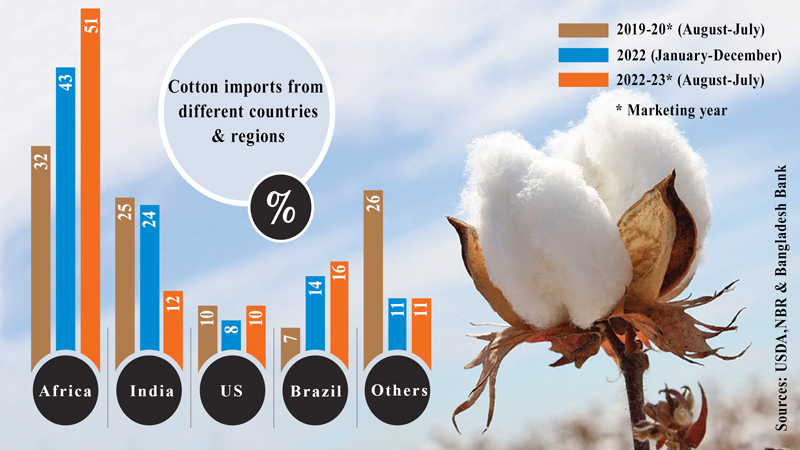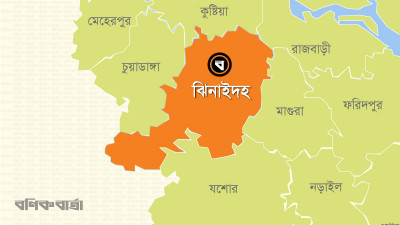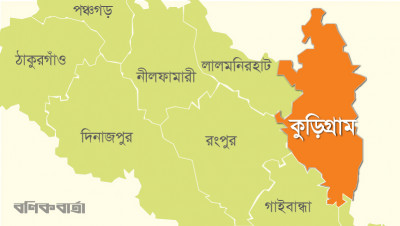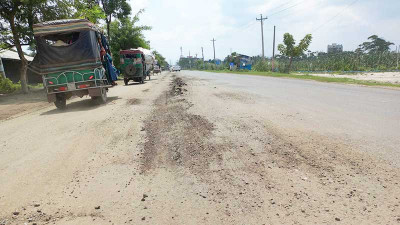 Bonik Barta graph
Bonik Barta graph Readymade garments (RMG) account for a staggering 85 percent
of Bangladesh’s total exports. The textile sector of the country provides all
the raw materials to the export-oriented industry. Most of the materials
produced in the mills and factories are cotton products. Therefore, cotton can
be described as the main component of the huge industrial activities. However,
Bangladesh produces a negligible amount of cotton. As a result, the country has
to rely on imports of this all important product.
Currently, the yearly demand of cotton stands at more or less
8.5 million bales (1 bale equals to roughly 218 kilograms). Despite purchasing
cotton from different countries, the country was dependent on India for cotton
imports for a long time. There has been a change in the source with the time.
Within four to five years, Africans countries have taken over India. At
present, more than 50 percent of the cotton Bangladesh needs is coming from the
African countries.
According to people concerned, Islamic Development Bank (IDB),
a financial institution based in Saudi Arabian city of Jeddah, is playing a key
role in Africa’s cotton trade. With the loans from IDB, the cotton exporters
from Africa set up warehouses at Port Klang in Malaysia. Bangladeshi importers
can bring cotton from there as per their need within seven days. The advantage
of using a third country port is working as the main catalyst in changing the
main source of cotton for Bangladesh.
“There are different complexities in storing cotton in the
country. Interest rates spike in the inventory. Therefore, warehouses situated
in a third country port are used,” Bangladesh Textile Mills Association (BTMA)
President Mohammad Ali Khokon told Bonik Barta.
“Many of the African cotton exporters have warehouses in
Malaysia’s Port Klang. They store cotton in accordance with the demand of the
Bangladeshi importers. And, the required cotton can be brought home within
seven days. The imports of cotton from Africa are on the rise mainly due to
this facility,” he said.
United States Department of Agriculture (USDA) keeps the yearly
(August-July) account of Bangladesh’s cotton imports. Based on information from
Bangladesh’s National Board of Revenue (NBR), USDA states, in 2022-23 fiscal
year, Bangladesh imported maximum amount of cotton from Western Africa. During
this period, 39 percent of the total demand was brought from this region.
Cameroon provided 9 percent while Chad sold 3 percent. So, in total, 51 percent
was imported from the countries in Africa. Besides, 16 percent was imported
from Brazil, 12 percent from neighboring India and 10 percent was imported from
the US.
People involved in the textile sector say that the quality of
African cotton is quite good. Aside from the quality, the prices of African
cotton are competitive and it takes less time to import. These are the reasons
cotton imports from Africa are going up.
“Among the African countries, the quality of cotton from
Cameroon is very good followed by Chad and Mali. But, one of the main reasons
behind the increase of cotton exports is African Cotton Association. Members of
the organization get special financial assistance from IDB enabling them to
export good quality cotton at competitive prices and in a short period of time.
And, Bangladeshi mill owners are able to take this advantage,” said BTMA
President Khokon.
Africa was not always the source of cotton for Bangladesh. Once
upon a time, cotton from Uzbekistan was quite popular. But, Bangladesh had to
move away from the Central Asian country after it was accused of allowing child
labor. Considering the prices and shipment time, India was a very important
source for relatively long time albeit the quality of Indian cotton-related
yarn and fabric was questionable. Besides, the neighboring country would impose
non-tariff barriers like export ban to meet its own demand. Owing to these bottlenecks,
the demand of African cotton has gradually gone up in Bangladesh.
According to BTMA information, Bangladesh exported 5.2 million
bales of cotton in 2010. Of it, over 1.1
million bales came from India which was 22 percent of the total imports. In
2015, a total of 6.1 million bales were imported, including 2.9 billion bales
from India. Indian cotton amounted to nearly 55 percent in the following year.
Currently, cotton imports from India slumped to 12 percent.
Even before the Covid era, India was a major source of cotton
for Bangladeshi importers. As per Bangladesh Bank statistics, the country
imported 25 percent of its cotton from India alone in 2019-20 marketing year. Apart
from it, 10 percent came from US and 9 percent from Australia. Besides, 8
percent was imported from African country of Benin and 16 percent came from Burkina
Faso and Mali – two African nations. Ivory Coast and Cameroon exported 5
percent each. In total, nearly one-third of Bangladesh’s cotton imports in that
marketing year came from African regions.
India was a large source even after Covid-19 pandemic. A USDA
report based on NBR statistics shows that 24 percent of Bangladesh’s cotton
imports were from India in 2022. Benin exported 16 percent, Brazil 14 percent,
Burkina Faso 10 percent and Cameroon sold 7 percent. Bangladesh imported 8
percent of its cotton in that year from US.
“Bangladesh produces yarn from good quality cotton. This is
why cotton imports from Africa and America are on the rise,” Bangladesh Knitwear
Manufacturers and Exporters Association (BKMEA) Executive President Mohammad
Hatem told Bonik Barta.
“This also means that the country is producing yarn using
cotton that is better than the Indian one. Bangladesh exports worldwide the garments
produced from these yarn and fabric,” he added.
Hatem also said, “Aside from ensuring the quality, uninterrupted
supply is also a major cause for changing the sources for cotton imports. Majority
of the cotton produced in China and India is used for local consumption. As a
result, India used to ban cotton exports often interrupting trade. Bangladesh
had to face this trade barrier regularly.”
Bangladeshi yarn and fabric producers claim that the quality
of Indian cotton was never satisfactory. If standards are taken into
consideration, Australian cotton comes first followed by US and Africa. Indian
cotton will be at number six or seven. Currently, apart from Eastern and
Western African countries, cotton is also imported from Brazil, Australia and
US. The quality of yarn depends on the quality of cotton. Garments are made
accordingly. Cotton from US, Brazil and Africa is required in case of high-end
garments. If there is a demand of Indian cotton it is only for local market.
According to member entities of Bangladesh Cotton Association
(BCA), there is not much difference in prices between Indian and African cotton.
Although far away, importance is given to African cotton rather than from neighboring
India only considering the quality. Besides, the Indian companies do not live
up to their pledges most of the time. Also, there are problems in manufactured
yarn and fabric due to low quality cotton. The dependency on Indian cotton
decreased to avoid these issues.
BCA President Mehdi Ali said, “Two decades ago, Bangladesh
used to import more cotton from US. After that, the importers started to import
from India taking the shipment time and cost into consideration. There is a
demand for good cotton produced in Gujarat and Orissa. If the quality was
maintained and promises were kept, India still would have been the main source
of cotton for Bangladesh.”
He also said, “From time to time, there was divergence between
Bangladesh’s garment exporters and Indian cotton exporters with regard to
certificates. Dishonesty of India in cotton trade is not seen in other source
countries.”






